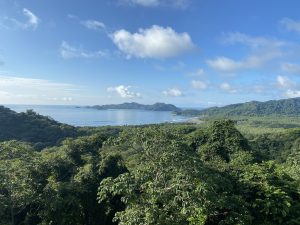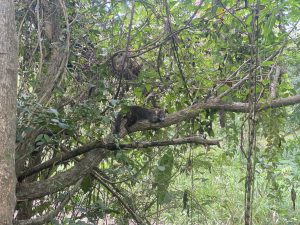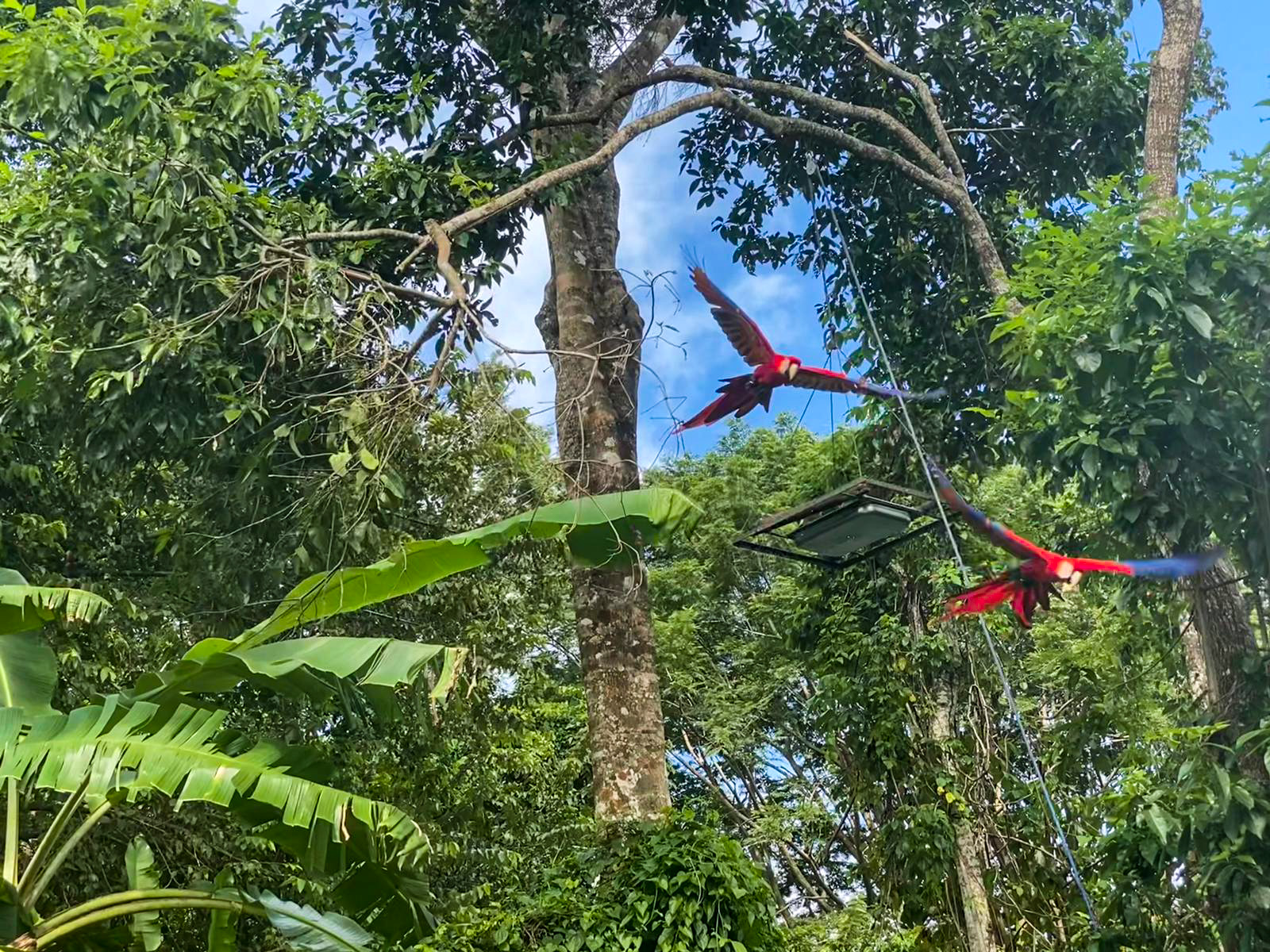Hace ya un par de semanas que he estado viviendo aquí en Costa Rica, y me sigue impresionando la gran variedad de sonidos que suelo oír a lo largo de un día aquí.
Me despierto con los aullidos de los monos congos, como si estuviera en una película de Indiana Jones, o como a mí me gusta imaginar, en uno de esos documentales preciosos narrados por David Attenborough. Me levanto y bajo al baño para lavarme los dientes, y de repente un grupo de lapas rojas salvajes vuelan por encima. Sus graznidos reverberan entre los árboles, y me quedo mirando hacia arriba hasta que parezcan ser pequeños puntos rojos contra el azul intenso del cielo.
Sin embargo, ese cielo azul no se ha dejado ver con tanta frecuencia en las semanas desde mi llegada. Estamos saliendo de lo que los ticos (el nombre coloquial utilizado para referirse a la gente costarricense) llaman la temporada verde, los meses del año cuando llueve más fuertemente y con más frecuencia. Supuestamente la estación seca tenía que haber empezado hace un par de semanas, pero como estoy aprendiendo, la naturaleza no hace caso a las normas de nadie, así que mis compañeros y yo quedamos a la espera de los días secos que nos dejarán disfrutar de las playas increíbles que atraen a tantos visitantes a Costa Rica.
 Eso no quiere decir que la temporada verde no tenga sus ventajas. Hay un animal que recorre los jardines de las personas que viven al borde de la selva en busca de comida. Se llama el pizote, y tiene la cara de un oso hormiguero peludo, el hocico de un cerdo con la capacidad de moverse 60° en cualquier dirección para sacar insectos del barro, y la cola diestra de un mono. Este animal sólo suele aparecer en tierras humanas durante la estación lluviosa, y cuando llegan los días secos, vuelve a las partes más profundas de la selva. Aunque le arruina la vida a cualquier persona que se olvide de guardar su comida en una caja cerrada con candado (aunque a veces encuentran la manera de abrir un candado), ver estas criaturas increíbles en sus intentos de robar cualquier zanahoria o huevo cocido dejado solo durante 20 segundos siempre me hace reír.
Eso no quiere decir que la temporada verde no tenga sus ventajas. Hay un animal que recorre los jardines de las personas que viven al borde de la selva en busca de comida. Se llama el pizote, y tiene la cara de un oso hormiguero peludo, el hocico de un cerdo con la capacidad de moverse 60° en cualquier dirección para sacar insectos del barro, y la cola diestra de un mono. Este animal sólo suele aparecer en tierras humanas durante la estación lluviosa, y cuando llegan los días secos, vuelve a las partes más profundas de la selva. Aunque le arruina la vida a cualquier persona que se olvide de guardar su comida en una caja cerrada con candado (aunque a veces encuentran la manera de abrir un candado), ver estas criaturas increíbles en sus intentos de robar cualquier zanahoria o huevo cocido dejado solo durante 20 segundos siempre me hace reír.
El mes que viene espero explorar más la zona donde estaré viviendo estos meses, y conocer más la cultura costarricense.
¡Pura vida!
~~~~~~~~~~~~~~~~~~~~~~~~~~~~
I’ve now been living in Costa Rica for a few weeks, and I’m still amazed by the huge variety of sounds I tend to hear over the course of a day here.
 I wake up to the shrieks of howler monkeys, as if I was in an Indiana Jones movie, or as I like to imagine, in one of those beautiful documentaries narrated by David Attenborough. I get up and go downstairs to brush my teeth. Suddenly a group of wild scarlet macaws flies overhead, their squawks echoing through the trees, and I stare up at them until they look like small red dots against the intense blue of the sky.
I wake up to the shrieks of howler monkeys, as if I was in an Indiana Jones movie, or as I like to imagine, in one of those beautiful documentaries narrated by David Attenborough. I get up and go downstairs to brush my teeth. Suddenly a group of wild scarlet macaws flies overhead, their squawks echoing through the trees, and I stare up at them until they look like small red dots against the intense blue of the sky.
However, I haven’t seen much of that blue sky in the weeks since my arrival. We are coming out of what the ticos (the colloquial name used to refer to Costa Rican people) call the temporada verde (green season), the months of the year when it rains more heavily and more often. Supposedly the dry season should have started a few weeks ago, but as I’m discovering, nature doesn’t follow anyone’s rules, so my colleagues and I are eagerly awaiting the dry days that will allow us to enjoy the incredible beaches that attract so many visitors to Costa Rica.
That doesn’t mean to say, however, that the temporada verde doesn’t have its advantages. There is an animal that roams the garden of those who live on the edge of the jungle in search of food. It is called the coati, or pizote in Spanish, and it has the face of a fluffy anteater, the snout of a pig with the ability to move 60° in any direction to pull insects out of the dirt, and the dexterous tail of a monkey. This animal only tends to appear on human soil during the rainy season, and when dry days arrive, it returns to the deepest parts of the jungle. Although they ruin the life of anyone who forgets to keep their food in a box locked with a padlock (although they sometimes even find a way to open a padlock!), seeing these incredible creatures in their attempts to steal any carrot or boiled egg left alone for more than 20 seconds never fails to make me laugh.

This month I hope to explore the area where I’m living in more depth, and get a deeper understanding of Costa Rican culture.
¡Pura vida!*
*This is a phrase that literally means “pure life”, but is used by ticos to express anything from “hello” to “goodbye”, “thank you” to “you’re welcome” and everything in between.
